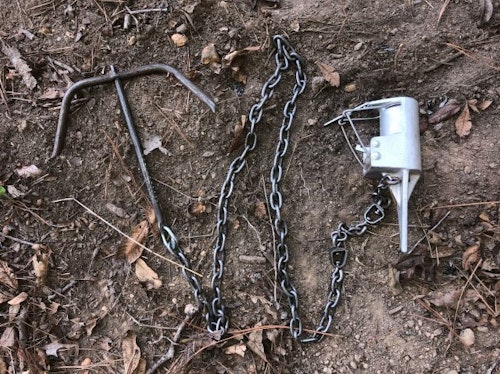If you’ve paid attention to any of the fur reports over the past several years, you already know the story — fur prices are down. In past decades, if a trapper worked hard and was successful, he could expect to collect a nice pay check at the end of the season. With modern fur prices where they are, many trappers don’t want to spend the time or money for such little gain. However, that doesn’t necessarily mean you shouldn’t set aside some aisle space for trapping gear.
Back in the day, every hardware store carried trapping equipment and supplies, because there were a lot more trappers. Today, this specialized gear is much harder to find. There are a number of websites that sell trapping gear, but a customer has to figure in shipping cost as well, because steel traps weigh a lot and skyrocket shipping expenses.
“If a business sells hunting gear, then it’s also good to carry trapping supplies,” suggests John Chagnon, Division Manager for PCS Outdoors (trapping-supply company). “Nine out of 10 times, trapping gear sells better than predator-hunting products. However, if a place only sells canoes and caters to the yuppies, then it’s not going to do good.”
You have to put in a little effort, though. Just because you have traffic doesn’t mean you’re going to sell traps. If no one on staff knows how to talk about trapping, then sales are likely to go down the toilet.
“I highly recommend that they have someone on staff that can talk trapping,” says Chagnon. “It’s like selling archery equipment and not having a bow guy. People don’t want to just buy a bow; they want someone who can set it up and work on it.”
What to Stock?
There’s no need to start off carrying hundreds of items. Start off with a few traps and the items that go with them. You don’t need a large display area, but make it look good and stock items in a logical way so customers can see how it all works together.
“If you’re selling traps, then sell accessory items, too,” explains Chagnon. “You’ll need to carry stakes for the traps. You’ll want to carry a trapper’s trowel — they are more heavy duty than a garden trowel, and people will buy them.”
It’s easy to get distracted when looking at a trapping-supply catalog or an online store because there are literally thousands of lures and baits and other gear. Don’t get anxious — talk to the supplier to find out what are some of the better-selling products, and just carry a couple of different brands of traps, lures and scents.
Traps typically have a low return rate because they are made of steel and are heavy-duty items. Remember, you want to have what a trapper needs, not everything under the sun. Plus, you can always add more later.
Other items to consider would be pack baskets. They look good on a display and trappers use them for all their gear, but non-trappers purchase them as well, to use for apple-picking and gardening. Because many of your customers will be new to trapping, make sure to carry informational materials such as books and DVDs on trapping. Carry a book or DVD on trapping coyotes, another one that covers water trapping and maybe something on fur handling.
Speaking of fur handling, that’s another segment of products you can branch into, such as skinning knives, tail strippers and small-game gambrels. Chagnon also recommends stocking snares if legal. He said a small pack of snares can make 100 percent margins, unlike small traps. Snaring is highly effective, too.

Don’t Forget About the Nuisance Trapper!
“If the trend continues and fur prices keep going down, trappers aren’t going to be wasting time trapping,” says Chagnon. “But then, you’re going to have the raccoons getting in the farmer’s corn. That’s where the dog-proof traps will do well.”
Anytime you can carry an item for a trapper that will also work for nuisance control, do it. Dog-proof raccoon traps are not only highly effective, but they are also inexpensive and easy to set and bait, and they typically don’t catch the neighbor’s dog. It’s good to stock cage or live traps for the gardener and homeowner, too. Dog-proof traps often work better than a live trap, but the customer has to be willing to dispatch the raccoon. With a live trap, they can move the animal somewhere if they don’t want to kill it. Body grip traps sell well for problem woodchucks and beavers, too. People like to buy those because the trap instantly dispatches the animal.
Nuisance traps sell best when you have a display showing that a customer can catch a raccoon or a coyote. Be sure that the display illustrates how the trap can help solve their problem and how easy it is to use. This goes a long way in helping a customer feel more confident when trying to make a decision to purchase a trap.
Don’t leave out mole traps and gopher traps, either. Those are hard to find and will sell to gardeners if these species are in your area. If there are skunks in your area, stock tube traps. These traps are designed to keep a skunk from spraying the trapper/homeowner.
Seasonality is a big aspect of trapping. Your fur trappers are going to be trapping from October through January, while your nuisance trappers will be needing supplies in the spring and summer. If you’re going to have an endcap, design it for fur-trapping supplies in the fall, then change it over to nuisance control in the spring and summer for the gardeners. Check with your local game warden if you don’t know what kind of furbearers or varmints live in your area and ask them what species the locals trap most. You want to provide products for locally targeted species.
“Once you get a local trapper as a customer and you have the gear available, he’ll come back,” says Chagnon. “He’s going to have to stock up on gear at the start of every season and he’ll probably be back to get stuff during season.”

Dog-Proof Coon Traps
Data from the U.S. Fish and Wildlife survey, “The Characteristics of U.S. Trappers,” revealed that racoons were the most commonly targeted furbearer nationally, with 62 percent of respondents saying it was a top-four targets species for them. Of those who trapped raccoons, 54 percent said they use dog-proof traps. The next closest trap selection was a 1.5 coil-spring leg-hold trap. Dog-proof traps appeal to the nuisance trapper who has racoons getting into the garden and trappers trying to make a buck. Here’s a list of solid brands often purchased by trappers. Traps and retail pricing from PCSOutdoors.com.
- Coon Dagger: The Coon Dagger is made by Sudden Valley Supply and features a diamond-shaped opening, which is said to allow for better grip pressure around the paw once the trap is tripped. This trap features a push/pull trigger and can be set to pull-only to eliminate dryfires when loading the trap with bait. Once loaded, the trigger can be switched back to push/pull. This trap features large drain holes for moisture and bait residue to flow out of. It comes with a welded machine chain attached to two multi-purpose swivels. $15 per trap.
- Duke DP: The Duke DP is a metal-tube style trap. It features a sensitive pull-only trigger, powerful coil springs and a spade head for easy insertion into the ground. The entire trap is powder coated in a dark brown paint that protects the metal and features a chain and swivel for anchoring. $11.50 per trap.
- Feather-Lite: This is a lightweight cast-aluminum tube-style trap with two inline-swivels and #2 straight-link chain. The pull-only trigger, springs and dog are all stainless steel. This is an American-made trap from AuSable Brand. $12 per trap.
- Z-Trap: This metal tube trap has double coil springs for fast catches and strong holds. The Z-Trap is powder coated and comes in a dark brown or a dipped camo version. The spring and push-pull trigger are protected with a zinc coating. A unique feature built into the Z-Trap is a stabilizing washer welded onto the metal stake. This helps stabilize the trap when sunk into wet ground and other soil types. Brown sells for $15 and a camo-dipped version for $16.

Pro Tip
Begin your trapping-supply hunt by reaching out to a reputable trapping-supply dealer. There are a number of good ones throughout the country. If you have a good local or in-state supplier, they can often set up booths at outdoor sales and store events and talk trapping with your customers and show off products you carry. Here are a few top trapping-supply dealers to get you started:
Kaats Bros. Lures www.kaatzbros.com
Fur Harvester’s Trading Post www.FNTpost.com
PCS Outdoors Trapping Supplies www.PCSoutdoors.com
Minnesota Trap Line Products www.minntrapprod.com
Hoosier Trapper Supply www.HoosierTrapperSupply.com
Schmitt Enterprises Trapping Supplies www.SchmittENT.com






